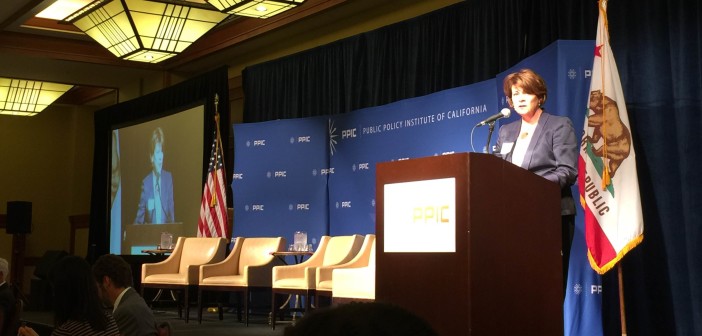On March 23, as part of its 2015 Speaker Series on California’s Future, the Public Policy Institute of California hosted a panel discussion, “Climate Change and California’s Future.”
The panel featured Ken Alex, director of the Governor’s Office of Planning and Research, Kevin Faulconer, mayor San Diego, Carl Guardino, president and CEO of Silicon Valley Leadership Group, and Dorothy Rothrock, president of the California Manufacturers and Technology Association.
Greg Dalton, executive producer and host of the weekly radio show, Climate One, moderated and asked the panelists questions about climate change, greenhouse gas reduction, renewable resources, drought, and other topics. Members of the audience also inquired about funding for green initiatives in rural areas, whether the state is pursuing climate change solutions urgently enough, and high-speed rail.
In their opening statements, Faulconer, Guardino, and Alex, expressed optimism about California’s ability to respond to climate change while remaining economically viable. Mayor Faulconer, a Republican, highlighted his ability to work with both sides to push for greenhouse gas reductions. Guardino, in true Silicon Valley fashion, tracked a hypothetical day enhanced by several tech-devices that reduce energy consumption, water consumption, and emissions.
Despite the magnitude of the problem, Ken Alex believes California is serving as a necessary beacon for environmental improvement.
Tempering the optimism, Dorothy Rothrock shared concerns about California’s AB 32, the Global Warming Solutions Act of 2006, which requires the state to reduce greenhouse gas emissions (GHGs) to 1990 levels by 2020. Rothrock stated that several provisions of AB 32 have not kicked-in. When they do take effect, it will become more expensive to do business in California, and California will become even more uncompetitive in attracting manufacturing companies.
Rothrock also questioned the efficacy of California’s cap-and-trade program, the centerpiece of California’s efforts to reduce greenhouse gasses. She noted that no other states have followed California’s lead in adopting a similar system. The program requires companies to hold emission allowances to cover their emissions, and companies can buy and sell allowances.
California also holds auctions where companies can purchase emission allowances. Auction revenue supports investments in the state to reduce GHG emissions, including clean transportation and water and energy efficiency. Alex explained that twenty-five percent of revenue from the cap-and-trade program is unallocated, and interest groups and industries are currently submitting proposals for how best to use these funds.
Responding to audience concern about paying attention to rural communities, Alex reassured the audience that rural areas have been greatly considered when determining how to distribute auction revenue.
Alex also discussed the controversial high-speed rail project in the context of SB 375, a bill adopted in 2008 that aims to reduce GHG emissions through coordinated transportation and land use planning. Alex acknowledged the price-tag of high-speed rail, but pointed out that high-speed rail is a preferable solution to meeting California’s increased transportation demands than building several new airport hubs.
Additionally, Alex highlighted high-speed rail’s ability to connect the central valley to the rest of the state, allowing people in rural communities to access major economic hubs more easily. High-speed rail also leads to transit-oriented development, which focuses on placing new development near transportation portals.
Ending on a positive note, Alex reminded that audience that California’s three largest utilities provided 22.7 percent of their electricity sales from renewable power in 2013. And California’s Renewable Portfolio Standard requires utilities to provide 33 percent of total procurement from renewable energy resources by 2020. In other words, we are making notable progress.

